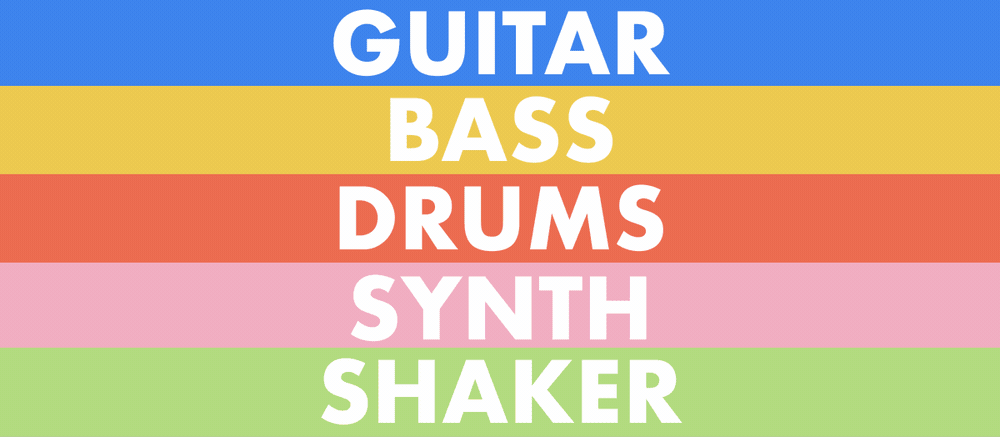Your Cart is Empty
⚠50% off code: SAMP50⚠
⚠50% off code: SAMP50⚠
⚠50% off code: SAMP50⚠
by Anders Johanson March 18, 2018 5 min read
Making music is like painting a picture. You start with the basic outline and shape, then gradually fill in the canvas with color, texture, light and shade, before adding some finishing touches. Making the right choices at all stages of the creative journey — from songwriting to tracking and arranging — can greatly speed up the mixdown process, result in a more polished track, and avoid the need to ‘fix it in the mix’.
When layering sounds, there are two major considerations at play: each sound’s frequency profile, and its amplitude over time. A plucked bass guitar note, for example, will typically have most of its information in the low-end of the frequency spectrum, with some upper-frequency information at the pluck part of the sound. Its envelope shape will normally have a fast attack and a slowly decaying tail. A gong smash, on the other hand, has a broad-band frequency make-up, with a slow attack and long sustain.
For centuries, arrangers and composers have thought about frequency make-up of the different instruments they are scoring for. Acoustic instruments have a set frequency range, governed by their physical size and resonant tendencies (among some other factors). Composers use these practical limitations to their advantage. When writing music for a string quartet, for example, a composer instinctively knows each instrument’s limitation: the double bass can reach very low frequencies, while the violin’s range extends into the highest registers. They score instrumental parts so that certain orchestral sections complement each other — call and response between the lower and higher parts of the ensemble, for example, or rousing glissandos that begin in the lower registers and end up with the highest notes.
Extending this concept to your compositions — even if your sounds are electronic — is a great way to manage the frequency make-up of your mix, and bring a professional sound to your finished tracks. Carefully choose instruments with non-competing frequency profiles to fill out your sonic canvas and keep the listener’s ear engaged. And don’t overuse the same instrument across the whole musical range, especially if you have a lot going on in your arrangement.

Busy mixes can be captivating and exciting, but overloading your tracks with instrumentation can be overwhelming to the listener, (let alone hard to mix). There are several ways to deal with busy mixes, but the first step is always to ask yourself ‘do I really need this part?’. To be able to answer this faithfully is the true test of a good producer: emotionally detaching yourself from the music you have toiled over, and judging it from an objective standpoint, to leave behind the purest artistic statement.
Experimentation with the placement of your musical parts within your arrangement is a good way to keep hold of passages you really love, but which threaten to clutter up your songs. It’s a common mistake to load all your musical ideas near the front of the song, so you get to the peak of musical energy quickly and have nowhere to go. If you have fallen into this trap, space out the musical motifs to allow the musical energy to build slowly and dynamically.
Another trick is to distill your musical ideas into lighter phrases. Maybe you have a complicated, two-bar guitar part that can be pared down to a few licks that do exactly the same job in the mix. Because there’s less sonic information, you will end up with more space, more dynamic range, and more impact in your mix.
Of course, if you’ve tried moving or adapting troublesome parts, and they still doesn’t belong, you might have no other option than to scrap them — the delete button is sometimes your best friend. Don’t throw your good ideas away forever, though — create an ideas folder for when you need inspiration down the line.

The dynamic character of any sound can be defined by its attack, decay, sustain and release — you’ll find these parameters on the amplitude envelope of a synthesizer, and on dynamics processors. By layering sounds with different dynamic characteristics, you can change their shape, to help drums punch without overwhelming the mix, make leads sound more pronounced without them being over-dominant, and keep sustaining tones sounding consistent.
Dynamic layering is time-consuming work. Let’s say you have a hard-hitting 808 kick drum, but your beat lacks low-end energy when you play it on a full-range sound system. You don’t want to lose the kick character you have already; you just need to beef up the low rumble. It’s not quite as simple as just placing a subby sample over every kick hit. First, you will need to tune the sample to make sure it fits in the key of your song. Next you need to shape the sound to make sure it doesn’t overwhelm your existing kick, or mask any of the other instruments. There are several tools you can use to do this, the first of which is a spectrum analysis meter (there are some good free ones online, and your DAW will most likely have one). Next is a compressor; you can use extreme attack and release controls to completely change the profile of the amplitude envelope. You can even route another instrument’s output to the compressor side-chain input to have your new sample’s dynamics shaped by the signal of another’s. You can also use a transient designer tool, which gives you comprehensive control over all of the above.
Remember that layering sounds, especially low-frequency ones, can result in strange EQ inconsistencies, caused by the emphasis and cancellation of certain frequencies when they come into and drift out of phase with each other. Close attention to the frequency profile of your sounds is required — you might need to make micro timing adjustments, whether in your sampler or on the timeline.

Dumping too much of your sonic information in one area of the frequency spectrum can make your mix an enormous headache. When layering kick drum and bass together, consider giving them dedicated frequency bands so they aren’t competing — use a frequency analyzer to determine where in the sonic spectrum each instrument is being most intense, and ring-fence that frequency so that only one instrument is active there. Other methods to manage this are to syncopate the kick and bass lines against each other so they aren’t always playing together.
The final piece of advice — something you’ve definitely heard before — is to listen to your favorite tracks and take note of how instruments like the ones in your compositions are layered. Do all the instruments play at the same time? Are certain tones noticeably filtered? There’s nothing wrong with taking your layering cues from the pros!

Receive discount codes on sample packs, free sounds to your inbox, and more! Seriously, we send out free sounds!